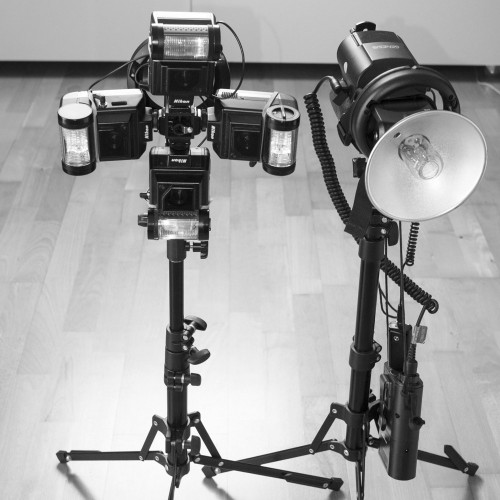Shootout 4x Nikon SB20 against 1x Genesis/Witstro GF400
At remote locations I need battery powered flash – either a quadruple set of speedlights or a bare-bulb flash. Both devices have more or less the same weight. The Nikon set is about 200€ (including 16 Eneloops, cable and a flash mount) and several weeks of work at Ebay while the Genesis kit (also sold as Godox, Witstro, Cheetah..) comes at 469€ from Calumet.
The big difference is with flash duration: The Genesis at 400 Watt (1/1) fires about 1/300s and at 4 Watt around 1/800s. There are rumors that HSS is possible with this unit but I could not test it as neither direct mounting on the camera nor the Genesis trigger allow for that. The SB-20 full power 1/1 comes within 1/1.200s, at 1/2 -> 1/1.500s, at 1/4 -> 1/3.700s, at 1/8 -> 1/7.400s and at 1/16 -> 1/15.000s.
How much light do I get from these old Nikon goodies? WS and GN do not have a direct relationship as emitted energy is not identical to light falling of a subject. Anyway, using the setup in the picture above and a Sekonic L-358 for measuring in a distance of 6 meter (ISO 125, 1/200s), I get the following F-stops for a single SB-20 flash
1/16 ->1.6
1/8 ->2.2
1/4 ->3.2
1/2 ->4.5
1/1 ->5.6
As expected the output is basically fourfold with 4 flashes
1/16 ->3.6
1/8 ->5.0
1/4 ->7.1
1/2 ->11.0
1/1 ->13.0
And here are f-stops for the GF400:
1/128 ->1.3
1/64 ->1.6
1/32 ->2.5
1/16 ->3.6
1/8 ->4.5
1/4 ->6.3
1/2 ->9.0
1/1 ->11.0
Taken together the 4 SB-20 give exactly 1 more f-stop than a 360/400 Watt bare bulb flash at full power. So we calculate each of these old Nikon flashes with about 90-100 Watt under the given conditions.
